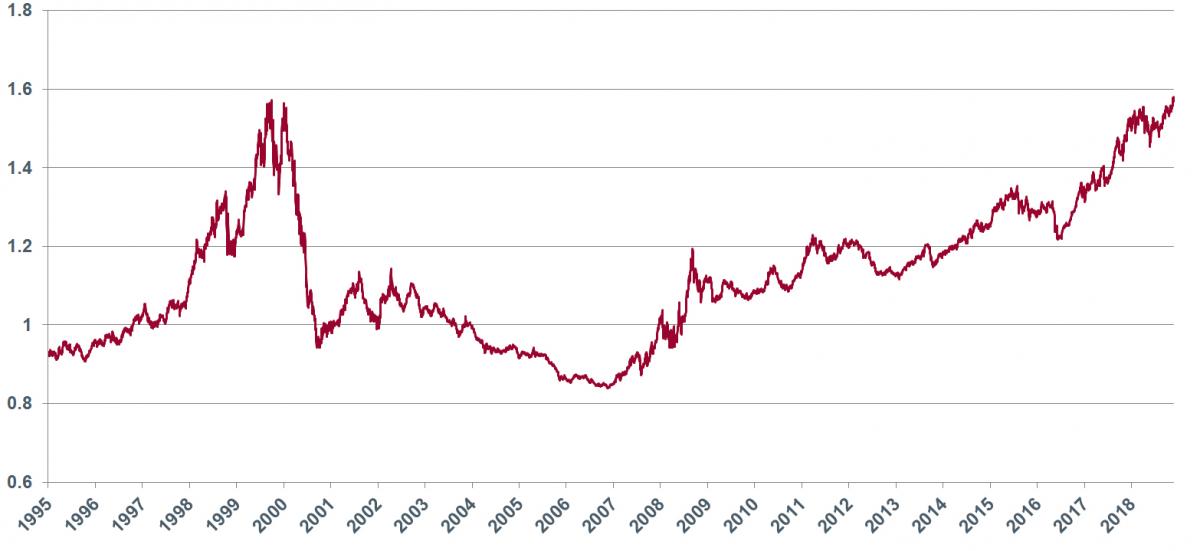27/05/2019
Flash boursier
Key data
| USD/CHF | EUR/CHF | SMI | EURO STOXX 50 | DAX 30 | CAC 40 | FTSE 100 | S&P 500 | NASDAQ | NIKKEI | MSCI Emerging MArkets | |
|---|---|---|---|---|---|---|---|---|---|---|---|
| Latest | 1.00 | 1.12 | 9'666.89 | 3'350.70 | 12'011.04 | 5'316.51 | 7'277.73 | 2'826.06 | 7'637.01 | 21'117.22 | 986.65 |
| Trend | |||||||||||
| %YTD | 2.05% | -0.26% | 14.68% | 11.64% | 13.75% | 12.38% | 8.17% | 12.73% | 15.10% | 5.51% | 2.16% |
Highlights:
1. Rising trade tensions
2. Global growth continues to trend upwards
Steering between conflicting crosswinds
The trade dispute between the United States and China has escalated a number of times in recent weeks and the two sides seem to have now dug in their heels on positions that are difficult to reconcile. On the face of it, the road to an agreement will be rough indeed. Yet equity markets have not taken a broadside hit and last week’s best-performing stocks were in defensive sectors that included pharma, consumer goods and insurance, whereas technology and semiconductors, in particular, fell sharply. In view of the concern expressed by users and companies, the US government took a small step back from the brink by granting the Chinese telecoms equipment manufacturer Huawei a three-month reprieve from sanctions.
Our basic scenario is that common sense will prevail regarding the two sides’ reciprocal interests, since neither China nor the US will derive any benefit from a deep downturn in their GDP. The New York Fed has calculated that the new slew of tariffs slapped on Chinese imports will cost American households (which contribute most to domestic growth) some USD 800 a year. The dispute is therefore bound to wind down eventually and, as a consequence, we are leaving our asset allocation unchanged. Presidents Xi Jinping and Donald Trump are set to meet privately at the next G20 summit in Japan.
Investors are currently steering between conflicting crosswinds, hoping for signs of stabilisation after the blow to their confidence dealt by trade tensions. The economic background nevertheless remains one of steadily rising global expansion, despite the waning cycle. This prospect could regain the upper hand in investors’ minds and underpin stockmarkets. Consumption indicators, in particular, are still buoyant. The OECD has just published its new global growth forecasts for 2019 and 2020 and has called upon governments to avoid a trade war. The organisation lowered its projection for global GDP growth by 0.1% to +3.2% for the current year while leaving the one for 2020 unchanged at 3.4%. Despite the circumstances, it raised its 2019 forecasts for both the US and the Eurozone.
The Chinese yuan stopped falling after officials warned that speculators who sell the currency short will inevitably face heavy losses.
The phenomenal rise of growth stocks

For almost 12 years now, so-called “growth” stocks have outperformed their rival “value” peers, i.e. shares that trade at a relative discount to their book value.
Although the definitions of growth and value stocks are not set in stone, the industry agrees broadly on at least two parameters:
- A value stock has a low price-to-book ratio.
- A growth stock is issued by a company with fairly high expected earnings growth.
The global leader when it comes to classifying stocks’ valuations is the S&P Dow Jones group. Its indices use an average of three criteria per category (including the two indicated above) to assign a style to each stock. For example, the S&P 500 universe is divided into two sub-indices: S&P 500 Value and S&P 500 Growth.
The Growth Index to Value Index ratio presented opposite shows that the prices of growth stocks have risen tremendously over the past 12 years and are now at their highest levels since the peak of the dotcom bubble in the early 2000s.
There are two explanations for this surge:
1. The market likes to dream, like it did during the dotcom bubble, so stocks such as Amazon and Facebook tend to make investors dream more than the “less fun” dividend stocks (even those that pay a high yield) issued by telecoms providers and utilities.
2. When discounting future earnings against interest rates, investors value stocks with high expected earnings growth more in periods when rates are low, as they clearly are at present.
Download the Flash boursier (pdf)


 Flash boursier
Flash boursier